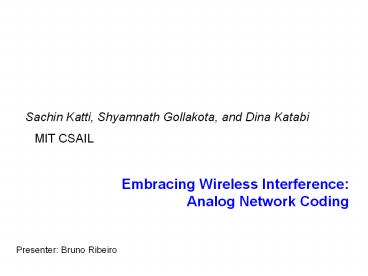Embracing%20Wireless%20Interference:%20Analog%20Network%20Coding - PowerPoint PPT Presentation
Title:
Embracing%20Wireless%20Interference:%20Analog%20Network%20Coding
Description:
Multiple user access channel ? Curious assertions: ... [1] B. Rimoldi and R. Urbanke, 'A rate splitting approach to the Gaussian ... – PowerPoint PPT presentation
Number of Views:127
Avg rating:3.0/5.0
Title: Embracing%20Wireless%20Interference:%20Analog%20Network%20Coding
1
Embracing Wireless Interference Analog Network
Coding
- Sachin Katti, Shyamnath Gollakota, and Dina Katabi
Presenter Bruno Ribeiro
2
Please disregard the following
- Strange statements
- Traditionally, interference is considered
harmful..... - Multiple user access channel ?
- Curious assertions
- Prior work, however, focuses
on capacity bounds and does not provide
an algorithm for delivering the resulting
throughput benefits. - 1 B. Rimoldi and R. Urbanke, A rate splitting
approach to the Gaussian multiple-access
channel, IEEE Trans. on Inform. Theory, 1996 ? - 2 Aline Roumy, David Declercq, and Eric Fabre,
Low Complexity Code Design for the 2-user
Gaussian Multiple Access Channel, ISIT 2004 ? - Published at SIGCOMM
- Best venue for physical layer papers?
3
Motivation I
Without network coding
Time step
1
2
4
3
Relay
A
B
With packet layer network coding
XOR A, B
Time step
1
2
3
Relay
A
B
4
Motivation II
Physical layer network coding
Time step
1
2
Relay
A
B
5
Network scenarios
A
R
B
A1
A2
A3
B
Unclear if claims carry over other scenarios
6
Constraints
- Minimum-shift keying modulation
- Would also work with PSK?
- Topology
- Restricted to certain 1-D, 2-D networks
- Received signal powers (RA and RB)
- Experiments say
- (SIR ? 0dB, -3dB)
- Hard to believe it works with RA ltlt RB
- Up to two simultaneous transmissions
- Relay can transmit with maximum power ?(RA RB)
- Flat-fading
7
Nice properties
- Asynchronous transmissions
- No channel allocation protocol (RTS/CTS)
- From network constraint
- Simple implementation (?)
8
MSK (Minimum-phase keying)
- Encode bits changing carrier phase
- ?/2 phase shifts
- Fixed amplitude
- Similar to OQPSK
- But no abrupt variations in amplitude
01
11
10
00
9
Papers MSK
- One bit / phase shift
- ?/2 zero
- -?/2 one
- Computed by finding the angle of r
10
Relay
- Very simple
- Receives signal
- Transmits same signal
- Amplified by ?
- Reasonable to assume ?(PAPB)/(RARB)?
- Does not model amplified background noise
- Assumes high SNR
11
Receiver
- Upon receiving signal
- Find amplitudes A and B
- Gives two possible values for ?n and ?n
12
Two possible values for ?n and ?n
For each value of n!
13
Obtaining amplitudes A and B
- First equation
If bits are random
- Second equation
14
Two possible values for ?n and ?n
Gives four phase difference pairs
15
Physical XOR part I
- Known
- For each n
- defines xy
- Knowing xy we can choose
min
16
Physical XOR part II
- Obtaining the message
17
Capacity bounds
18
Emulation
- Rate 500Kbps
- GNURadio is reported to achieve 1-2Mbps
- Topology 1-D, 1 relay, 2 senders
- Conclusions
- Better than pure MSK
- Needs 8 more FEC
- Graphs
19
Results
20
Results II
21
Overview (before discussion)
- Interesting first step
- Still a lot to be done
- Many unanswered questions (discussion..)
22
Discussion
- Node capable of 16-AQM
Reserved for relaying
Interesting to conserve energy?
23
Discussion II
- Topology too naïve
- Signal amplification at relay
- Increased network capacity?
Previous interference radius
R
New interference radius
24
Backup slides
25
Practical issues
- How does node A detect interference?
- Random transmission times to avoid pilot signal
interference - Pilot signal helps align signals
- Also helps reduce uncertainty
- Frequency offsets
- Channel distortion
- After pilot, encoded Src, Dest, packet ID








![get⚡[PDF]❤ Embracing Queer Family: Learning to Live Authentically in Our Families and PowerPoint PPT Presentation](https://s3.amazonaws.com/images.powershow.com/10042496.th0.jpg?_=20240530048)














![[PDF] DOWNLOAD Canning and Preserving Cookbook For Beginners: Canning Comfort: Embracing PowerPoint PPT Presentation](https://s3.amazonaws.com/images.powershow.com/10065456.th0.jpg?_=202406260710)



![[DOWNLOAD]⚡️PDF✔️ Canning and Preserving Cookbook For Beginners: Canning Comfort: Embracing the PowerPoint PPT Presentation](https://s3.amazonaws.com/images.powershow.com/10063760.th0.jpg?_=20240625059)



